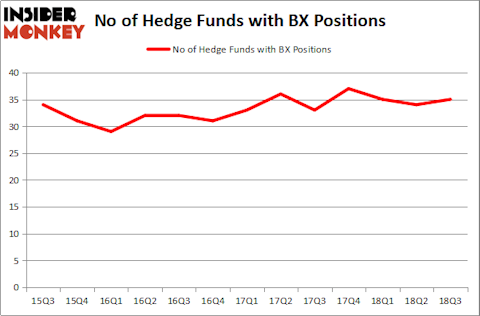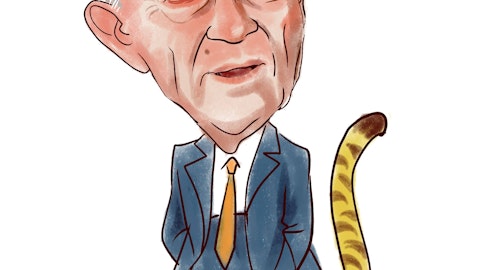Many investors, including Paul Tudor Jones or Stan Druckenmiller, have been saying for a while now that the current market is overvalued due to a low interest rate environment that leads to companies swapping their equity for debt and focusing mostly on short-term performance such as beating the quarterly earnings estimates. In the fourth quarter, many investors lost money due to unpredictable events such as the sudden increase in long-term interest rates and unintended consequences of the trade war with China. Nevertheless, many of the stocks that tanked in the third quarter still sport strong fundamentals and their decline was more related to the general market sentiment rather than their individual performance and hedge funds kept their bullish stance. In this article we will find out how hedge fund sentiment to The Blackstone Group L.P. (NYSE:BX) changed recently.
The Blackstone Group L.P. (NYSE:BX) was in 35 hedge funds’ portfolios at the end of the third quarter of 2018, which represents an increase in hedge fund sentiment lately, as there were 34 hedge funds bullish on the stock at the end of the previous quarter. Still, with the number of investors with long holdings of the stock slowly going up, the company wasn’t among the most favorite ones in the third quarter. (To see which stocks were widely popular in recent months take a look at the list of 30 most popular stocks among hedge funds in Q3 of 2018). We’ll continue with our analysis of the stock, trying to identify if it carries a good potential for investment.
In the financial world there are a large number of tools investors have at their disposal to grade stocks. A pair of the most under-the-radar tools are hedge fund and insider trading indicators. We have shown that, historically, those who follow the top picks of the best fund managers can outperform the broader indices by a solid amount. Insider Monkey’s flagship best performing hedge funds strategy returned 17.4% year to date and outperformed the market by more than 14 percentage points this year. This strategy also outperformed the market by 3 percentage points in the fourth quarter despite the market volatility (see the details here). That’s why we believe hedge fund sentiment is a useful indicator that investors should pay attention to.

While carefully investigating The Blackstone Group L.P. (NYSE:BX) we tracked this River Park Large Growth Fund’s Third Quarter 2018 Performance Summary, in which it thoroughly discusses the company’s performance and its view on it. Here is that part of the letter:
“BX shares currently trade at about 11x our estimate for 2019 distributable earnings per share vs. a 15x multiple for the company at the time of its 2007 IPO and about a 17x earnings multiple for the average company in the S&P 500 at that time and currently. 4 BX also offers a substantially higher dividend yield than the market as a whole (about 6% compared to the 2% current yield on the S&P 500), a yield that has also expanded during the company’s time as a publicly traded entity and is amongst the highest dividend yields of the largest 150 public companies in the U.S. Although it has generally been our experience that high performing, high conviction stocks see their valuation multiples expand relative to the market over time, Blackstone is the less common example of the reverse–a strong performer that, despite its exceptional growth, sees its valuation multiple shrink.
Today, Blackstone is the largest alternative asset manager in the world with total assets under management (AUM) of $439 billion. The business was established in 1985 by current chairman Stephen Schwartzman and his partner Pete Peterson, who left Lehman Brothers to start their own investment firm with about $400,000 of equity capital. Through strong performance, innovation and diversification, BX has grown its AUM at a mid-20% compound annual rate for the past 30+ years to the business it is today. The firm was brought public in 2007 in a high profile IPO at an offering price of $31 per share (as compared to its current price of $35) less than a year before the 2008 financial crisis. Although the IPO was at first well received, the market meltdown and collapse of the financial markets took the hype out of investors’ perception of the company and its stock price plunged to under $4 per share in early 2009. Despite its stellar AUM growth throughout the crisis–and the steady growth of its earnings power and dividend payments–the shares, at $35 today, are not materially higher than at the time of its IPO 11 years ago.
We recently attended the company’s analyst day in New York–its first since 2014. During the presentation, BX’s newly minted president and COO Jon Gray highlighted the attributes that he believed set BX apart and should give investors’ confidence in the company’s future. This slide of those attributes that make BX such a “truly great business” is reproduced below.
We believe this slide is also as good a list as we’ve come across that highlights the attributes we focus on in our research to identify truly great businesses as potential holdings for our portfolio. In Blackstone’s case, the attributes underlying these characteristics are extremely compelling.
For example, as for growth, the company’s AUM since its 2007 IPO have grown 5x from $88 billion to $439 billion (a compound annual rate of 16% per year) despite returning over $260 billion in capital to investors over that time. AUM growth has been remarkably steady and strong–even through the great financial crisis–and has recently accelerated with 18% growth in AUM in 2017 and $120 billion of gross inflows in the last 12 months alone. The vast majority of the firm’s asset growth has been organic (rather than by acquisition), as increased fundraising momentum for its flagship private equity and real estate funds has been augmented by innovative launches of new sectors and strategies, including hedge fund solutions, credit, energy and infrastructure. Substantial AUM growth has combined with strong and stable fees at the firm to lead to dramatic growth in Blackstone’s earnings .5 Since 2010, BX’s distributable earnings have grown nearly 10 fold from $461 million to over $4.3 billion projected for 2018, a 22.5% compound rate of growth.
Blackstone’s strong AUM growth has been fueled by both a powerful secular trend in favor of alternative managers within the asset management industry as well as best-in-class investment results across nearly all strategies. As to the secular growth of the industry, institutional investors have been increasing their allocations to alternative strategies (currently a $10+ trillion industry) for the last 15 years, a shift that accelerated since the 2008 financial crisis in response to equity and debt market volatility and the ensuing ultra-low interest rate environment. This secular growth is expected to continue driving strong inflows to the leading firms as larger allocation pools (such as retail and private wealth) embrace the industry.
Secular growth, however, can only take a company so far as execution and market share gains within a secular growth industry are still critical for a company to thrive. Here, BX’s performance has been exceptional. In its core private equity and real estate funds (its oldest and largest franchises), Blackstone has returned an average of 2.2x its investor’s capital and has consistently ranked at or near the top of the charts amongst all of its peers. The net internal rate of return for the company’s private equity funds since 1987 has been 16% per year, which has outperformed the S&P by 800 bps annually. As a result, Blackstone has continued to take share in a secularly growing industry, a scenario that we expect to remain in place for years to come. The company recently stated that it is targeting in excess of $1 trillion in AUM and over $6 per share in distributable earnings as its new run rate goal to be accomplished within the next 7-10 years, both of which, we believe, could prove to be conservative. It is fair to say, then, that by every measure, Blackstone’s business has exhibited impressive growth.
With respect to some of the other characteristics on its investor day slide, the company also excels. For example:
- Limited need for capital: BX has no net debt (and over $1.7 billion of net cash), an A+ credit rating (the highest of any alternative manager) and has had minimal dilution in its share count (only a 0.7% increase in shares outstanding) since its IPO 11 years
- Magnet for talent: For its 2018 analyst class of 86 hires, BX had 14,906 applicants (a hiring rate of only 0.6%, well below that of the most prestigious universities in the world).
- Profit margins: Trailing 12 month pre-tax margins of 52% are amongst the highest in the public markets where the median pre-tax margin in the S&P 500 is 13%.
- Recurring revenue base: The vast majority of revenues are tied to either perpetual or long-term vehicles in which the average remaining commitment is approximately 12 years.
- Strong free cash flow: Since 2010, BX has generated over $17 billion in cumulative distributable earnings resulting in nearly $12 in dividends paid out per share over the past 7 years. In addition to steadily growing its dividend, BX recently added a share buyback program with a $1 billion authorization to distribute even more of its excess free cash flow back to shareholders.
On the next page, you can read both the rest of the RiverPark’s and Insider Monkey’s analysis of the stock.
While more difficult to quantify, we believe the firm also is amongst the leaders in the public markets in the additional characteristics of loyal customers, the strength of its global franchise, the depth of its competitive moat and its brand equity.
Despite this record of success and its strong future prospects, BX’s stock has been, at best, an average performer since its 2007 IPO.7 BX shares have also materially underperformed its business fundamentals. This mediocre stock performance is, we believe, among other things, a function of (1) the timing of the company’s IPO (at the beginning of the financial crisis), (2) the fact that the accounting for unearned performance fees gives the appearance of earnings volatility (despite what we view as one of the more predictable cash flow generating companies in the market), and (3) its structure as a limited partnership (which results in complex accounting as well as shareholders having to deal with K-1 reports when filing their tax returns). Although we are not banking on multiple expansion in our investment thesis for BX, we do believe that the company is entering a period in which its earnings growth and dividend payouts will increase more steadily given the size of its asset base and the expected realization stream from assets the firm raised post-financial crisis. In fact, at its analyst day, BX management guided to a 50% increase in fee related earnings over the next two years as its larger mandates come on line. We also believe that the company is entering a period of more robust incentive fee earnings as some of its more successful funds enter their more mature harvesting phases. More robust incentive fees plus significant growth in fee-related earnings should result in an acceleration and a more predictable trend of distributable earnings growth. In addition, the management team is actively considering a potential change in corporate structure to a traditional C corporation, which has the potential to expand the firm’s shareholder base (broad market indices, for example, do not include BX as a result of its structure) as well as to reduce the complexity of its reporting.
Although this would come with a higher tax bill, it is possible that the market would afford a much higher multiple to the company as a traditional C Corp (as has been the case for BX competitor KKR, which converted earlier this year).
Given its current low valuation, we anticipate that the company’s stock will at least keep pace with what we believe will be its well above average earnings growth of 15%+ per year for the foreseeable future. However, as with all of our holdings, we would welcome the challenge ofmanaging down our position size over time should the company’s shares materially outperform its earnings growth over the next few years and be afforded a valuation more in-line with, or at what we believe would be a well-deserved premium to, that of the average company in the S&P 500.
While we remain extremely positive about our BX position, we also believe that the
characteristics in its “truly great business” slide above presents a list of attributes that each of the other companies in our portfolio could also use to describe their businesses at any of their future analyst days.
For example, as to growth, as a whole our portfolio companies have grown revenue at a 20% compound annual growth rate over the past three years (three times the market growth rate) and are forecast by Street analysts to grow more than 15% per year for the next three (two times the market growth rate).8 That revenue growth has translated into even higher earnings growth given that our portfolio companies have high margins (31% EBITDA margins versus 19% for the market) that are expanding. This has resulted in earnings, on average, throughout our portfolio consistently growing faster than revenue. EPS for our portfolio companies have grown 24% per year over the past three years (almost four times the market) and are forecast to grow more than 18% per year for the next three (more than twice the market).9 It should be noted that our internal projections are even more robust than Street projections for our portfolio companies.
Similar to Blackstone, many of our holdings have a limited need for capital (43% of our portfolio is represented by companies with no net debt) and generate significant free cash flow (e.g. CME generated $1.8 billion of operating cash flow and spent less than $100 million on capital expenditures, Mastercard generated $5.6 billion and needed only $300 million for capital expenditures, and Adobe generated $2.9 billion while spending only $175 million on capital expenditures).10 Most are also impressive global franchises with loyal customers and significant brand equity, such as Apple, Google, Amazon, Facebook, Visa, Mastercard, Nike, Adidas, and Schlumberger, which also have substantial moats. For example, Visa and Mastercard have a global oligopoly in payments, Adobe enjoys a virtual monopoly in the multimedia software industry, patents protect the core innovations underlying the products for Align Technology, Intuitive Surgical, Exact Sciences and Illumina, Equinix’s global footprint far exceeds that of any of its competitors (75% larger than the second largest player in the industry), and Alphabet and Facebook utterly dominate in eyeballs and ad dollars in search and social media.
It has always been our belief that owning truly great businesses–as long as they trade at attractive valuations–is the best way to compound one’s money in the equity markets. Such companies generally thrive regardless of the current political, economic or market landscape and tend to perform well in both rising and falling markets. If purchased at attractive valuations, we believe it is more than reasonable to earn equity returns that are at least commensurate with these companies’ long-term earnings growth rates, which are often at a 2-3x multiple to the long term average returns in the equity markets.
As with Blackstone, we believe that the companies we own in the RiverPark Large Growth Fund are truly great businesses. And, because, on average as with Blackstone, the growth of earnings throughout our portfolio has been greater than the total return for the stocks, we continue to believe that the valuations for these companies are attractive and give us great confidence in the overall prospects for our performance in the years to come.”
Now, it’s time to take a look at the recent hedge fund action surrounding The Blackstone Group L.P. (NYSE:BX).
How have hedgies been trading The Blackstone Group L.P. (NYSE:BX)?
At Q3’s end, a total of 35 of the hedge funds tracked by Insider Monkey were long this stock, a change of 3% from one quarter earlier. By comparison, 37 hedge funds held shares or bullish call options in BX heading into this year. With the smart money’s positions undergoing their usual ebb and flow, there exists an “upper tier” of notable hedge fund managers who were increasing their holdings substantially (or already accumulated large positions).

Of the funds tracked by Insider Monkey, Select Equity Group, managed by Robert Joseph Caruso, holds the most valuable position in The Blackstone Group L.P. (NYSE:BX). Select Equity Group has a $245.2 million call position in the stock, comprising 1.8% of its 13F portfolio. On Select Equity Group’s heels is Robert Joseph Caruso of Select Equity Group, with a $197.1 million position; the fund has 1.5% of its 13F portfolio invested in the stock. Other professional money managers with similar optimism include Mick Hellman’s HMI Capital, Richard Chilton’s Chilton Investment Company and Tom Gayner’s Markel Gayner Asset Management.
As aggregate interest increased, some big names were leading the bulls’ herd. PEAK6 Capital Management, managed by Matthew Hulsizer, established the largest call position in The Blackstone Group L.P. (NYSE:BX). PEAK6 Capital Management had $6.9 million invested in the company at the end of the quarter. Sander Gerber’s Hudson Bay Capital Management also made a $3.8 million investment in the stock during the quarter. The other funds with brand new BX positions are Paul Marshall and Ian Wace’s Marshall Wace LLP, Kevin D. Eng’s Columbus Hill Capital Management, and Robert Rodriguez and Steven Romick’s First Pacific Advisors LLC.
Let’s now review hedge fund activity in other stocks similar to The Blackstone Group L.P. (NYSE:BX). We will take a look at Marriott International, Inc. (NYSE:MAR), Capital One Financial Corporation (NYSE:COF), Infosys Limited (NYSE:INFY), and Ecolab Inc. (NYSE:ECL). This group of stocks’ market caps are closest to BX’s market cap.
| Ticker | No of HFs with positions | Total Value of HF Positions (x1000) | Change in HF Position |
|---|---|---|---|
| MAR | 29 | 1552733 | -13 |
| COF | 47 | 2509533 | 7 |
| INFY | 18 | 1130365 | 2 |
| ECL | 23 | 2568307 | -7 |
As you can see these stocks had an average of 29 hedge funds with bullish positions and the average amount invested in these stocks was $1.94 billion. That figure was $615 million in BX’s case. Capital One Financial Corporation (NYSE:COF) is the most popular stock in this table. On the other hand Infosys Limited (NYSE:INFY) is the least popular one with only 18 bullish hedge fund positions. The Blackstone Group L.P. (NYSE:BX) is not the most popular stock in this group but hedge fund interest is still above average. This is a slightly positive signal but we’d rather spend our time researching stocks that hedge funds are piling on. In this regard COF might be a better candidate to consider a long position.
Disclosure: None. This article was originally published at Insider Monkey.





